Hip stiffness leads to many painful conditions in and around your hip. In older adults, limited hip mobility is associated with hip arthritis, spinal stenosis, and knee arthritis. In athletes, hip stiffness is linked with hip impingement, labral tears, groin pain, low back pain, and knee pain. This article highlights 5 hip mobility exercises that will help you move with less pain.
Hip Joint Basics
Your hip joint is a large ball and socket joint similar to your shoulder. Unlike your shoulder, your hip socket is much larger than the ball. Therefore, less mobility is available at your hip in comparison to your shoulder. In addition, further loss of hip motion is due to bony changes to your femur or pelvic bone. This occurs with aging. Also, common restrictions are due to muscle and joint capsule tightness.
Hip Mobility Exercises

Manual therapy soft tissue techniques and various forms of stretching will improve your hip mobility. For lasting changes to occur, manual therapy is combined with self-mobilization exercise. Self-mobilization exercises are performed in your home with minimal space or equipment. The exercises that follow in this article are basic self-mobilization techniques that you can perform in your home or local gym.
Prone Figure-4 Hip Self-Mobilization
The figure-4 self-mobilization is helpful if you have limited hip external rotation. This is the right stretch for you if you experience difficulty putting on your shoes and socks. It will also improve your hip extension which can translate into improved walking or running ability. When performing this exercise it is important to activate your abdominal muscles to avoid arching your lower back.
Quadruped Hip Internal Rotation with Lateral Distraction
Limitations in hip internal rotation are characteristic of many hip problems. Any sport that requires squatting, pivoting, planting, and cutting requires hip internal rotation. By using a belt or band to distract your hip joint, greater hip internal rotation is available. Be sure to place the band or belt deep into your groin to optimize the stretch.
Quadruped Rock Back with Hip Posterior Glide
Rockbacks promote a posterior glide of your femur and stretch the back of your hip. With this exercise, we like to keep the hip flexion passive. This is because passive motion alleviates the influence of your hip flexor muscles. By using a belt or band to distract your hip joint, greater hip flexion is available.
Kneeling Hip Flexor Self-Mobilization
Limited hip extension flexibility is one possible cause of an increased anterior pelvic tilt and low back arching during walking or running. This pattern stresses the structures of your lower back and hip. Combining this self-mobilization with abdominal strengthening exercises alleviates low back and hip pain.
Standing Posterior-Lateral Hip Self-Mobilization
Tightness in the back of your hip can lead to pain in the front of your hip or groin. Stretching this region will help. By using a belt or band to distract your hip joint, greater hip motion is available without pain. If you do experience pain, adjust the height of the step or shift more weight onto your opposite leg.
Get More Help with Hip Mobility Exercises
Perform hip mobility exercises after a dynamic warm-up. Elevating your body temperature and activating your nervous system will lead to the best results.
Ideally, mobility exercises will result in a mild to moderate stretching sensation. Muscle re-education and strengthening exercises always follow once the new range of motion has been gained.
Finally, it takes consistency and time to achieve lasting gains. If you would like help from your physical therapist, give us a call.

